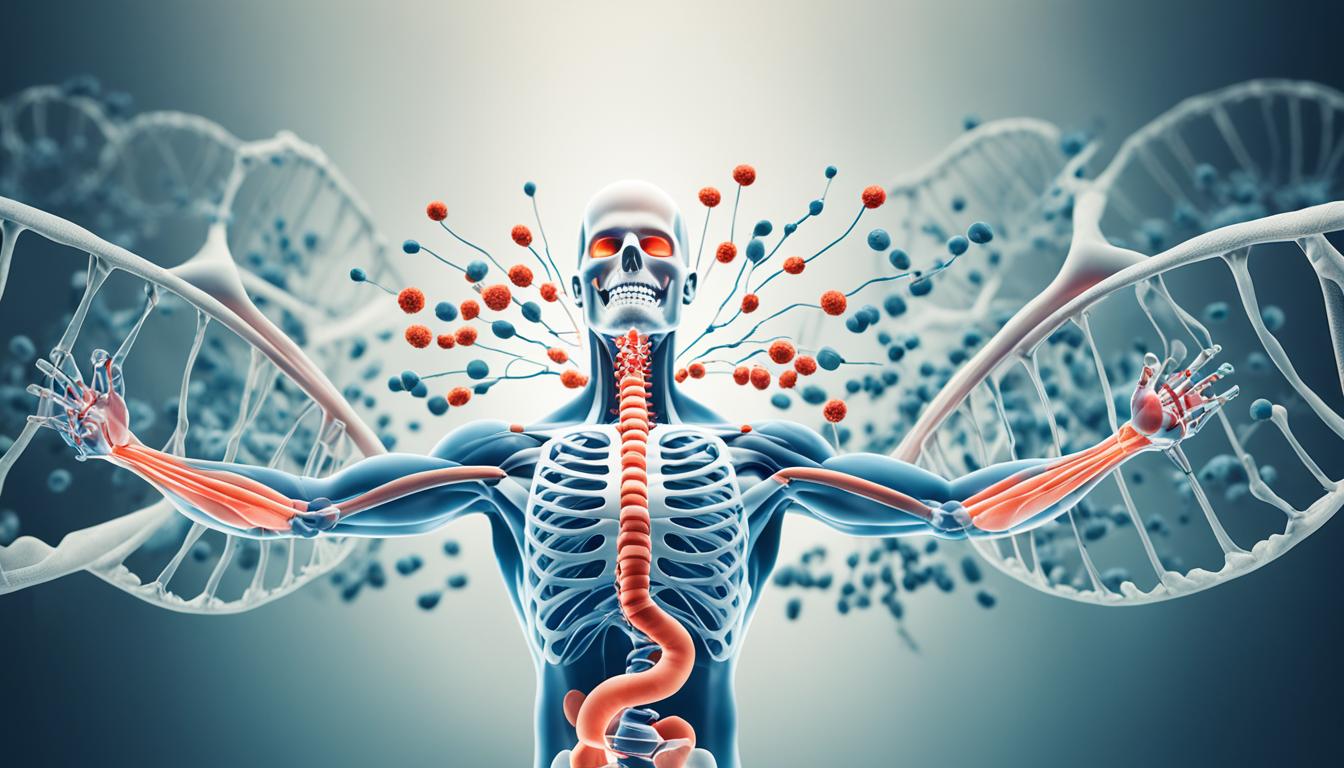Marfan syndrome is a genetic disorder that affects how the body makes healthy connective tissue. This affects various parts like the bones, eyes, heart, and more. The signs can be different for everyone, from not serious to quite obvious. People might have body shape differences, eye problems, heart issues, and more.
It’s often something you get from your parents, but it can show up new in a person. It’s known for causing dangerous heart issues, making early discovery really important. Cardiovascular complications are a big risk for those with Marfan’s.
Figuring out if someone has Marfan syndrome involves a close look at their health history and symptoms. Doctors also use special tests like genetic testing, echocardiograms, and other scans. The Marfan Foundation helps a lot by offering info and support to those dealing with this condition.
How Marfan syndrome is treated depends on how it’s affecting the person. It might involve taking medicine, having surgery, or receiving other kinds of help. Thanks to modern treatments, many people with Marfan can live full and active lives.
Key Takeaways:
- Marfan syndrome is a genetic disorder that affects the proteins responsible for healthy connective tissue development.
- Symptoms of Marfan syndrome can vary and may include skeletal abnormalities, vision changes, cardiovascular issues, and other related symptoms.
- Marfan syndrome can be diagnosed through clinical evaluation, family history assessment, genetic testing, echocardiograms, and imaging studies.
- Treatment options for Marfan syndrome vary and may include medications, surgery, and other therapies.
- The Marfan Foundation provides resources and support for individuals and families affected by Marfan syndrome.
Understanding Marfan Syndrome
Marfan syndrome is caused by a change in the fibrillin-1 gene. This change affects the body’s connective tissue. It leads to issues with how the fibrillin-1 protein works. This change can cause many symptoms and problems.
One key sign of Marfan syndrome is the growth of bones. This can make someone taller with longer limbs. It can cause issues with how the body looks and moves.
Marfan syndrome also affects the eyes, heart, and blood vessels. The eyes might not see well or the lens might move. The heart and blood vessels can have issues, like weak heart valves or a bulging aorta. These conditions can be serious.
People with Marfan syndrome might have trouble with their skin, lungs, and other tissues. The problems can vary a lot. Even family members may have different symptoms.
In bad cases, Marfan syndrome can be deadly. It might lead to a problem where the aorta tears. This can cause bleeding inside the body. Doctors need to keep a close eye on those with Marfan. They also need to offer the right treatments.
| Symptoms | Complications |
|---|---|
|
|
Diagnosing Marfan Syndrome
To diagnose Marfan syndrome, doctors look closely at a patient’s family history and how they look. They pay special attention to bone shape, heart health, and eye issues. This helps in finding out if they have signs of the syndrome.
A key part of diagnosing Marfan syndrome is a DNA test. This test checks for a change in a gene called fibrillin-1. If this gene has a mutation, then the person likely has Marfan syndrome. This test is very certain.
Doctors also use special pictures of the heart, like echocardiograms. These images check the heart and the aorta. The aorta is checked for being too big or having weak spots. Other scans, such as MRIs and CT scans, may also be needed. They help check other parts of the body for signs of the syndrome.
It is very important for those who might have Marfan syndrome to get all these tests. It helps the doctors give the right treatment.
Diagnosing Marfan Syndrome: An Overview
Diagnosing Marfan syndrome includes a close look and special tests. Below is a summary of how doctors check for the syndrome:
| Diagnostic Step | Description |
|---|---|
| Clinical Evaluation | Doctors check the patient’s family and how they look. This helps spot possible signs of Marfan syndrome in the bones, heart, and eyes. |
| Genetic Testing | A DNA test confirms Marfan syndrome. It checks for a change in the fibrillin-1 gene. |
| Echocardiogram | Doctors take images of the heart with sound waves. This checks the aorta for any issues. |
| Imaging Studies | Other tests like MRIs and CT scans are used. They check different parts of the body for signs of Marfan syndrome. |
Following these steps helps doctors diagnose Marfan syndrome correctly. This allows them to create a treatment plan suited to the patient.
Advancements in Stem Cell Therapy for Marfan Syndrome
Stem cell therapy is becoming a hopeful field for Marfan syndrome treatment. Researchers are looking into how stem cells might help heal weak connective tissue. This tissue is often found in the aorta and can lead to a dangerous condition called aortic aneurysm in people with Marfan syndrome.
Recent studies discovered that a drug called irbesartan could be useful in Marfan syndrome. It’s a medicine used for high blood pressure. This drug might help slow down how fast the aortic root grows in people with Marfan syndrome.
Scientists are also experimenting with stem cells from Marfan syndrome patients to learn more about the disease. They hope to uncover new ways to treat Marfan syndrome. Though more studies are necessary, these early findings are promising for the future of treatment.

